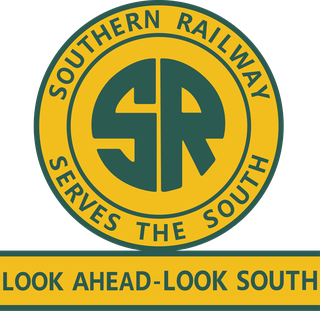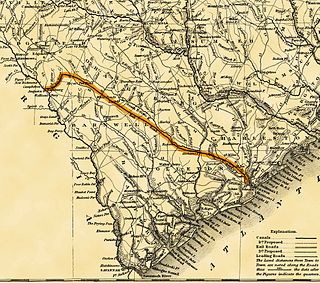
The Interstate Commerce Commission (ICC) was a regulatory agency in the United States created by the Interstate Commerce Act of 1887. The agency's original purpose was to regulate railroads to ensure fair rates, to eliminate rate discrimination, and to regulate other aspects of common carriers, including interstate bus lines and telephone companies. Congress expanded ICC authority to regulate other modes of commerce beginning in 1906. Throughout the 20th century several of ICC's authorities were transferred to other federal agencies. The ICC was abolished in 1995, and its remaining functions were transferred to the Surface Transportation Board.

The Safety Appliance Act is a United States federal law that made air brakes and automatic couplers mandatory on all trains in the United States. It was enacted on March 2, 1893, and took effect in 1900, after a seven-year grace period. The act is credited with a sharp drop in accidents on American railroads in the early 20th century.

Wooden railroads, called wagonways, were built in the United States starting from the 1720s. A railroad was reportedly used in the construction of the French fortress at Louisburg, Nova Scotia, in New France in 1720. Between 1762 and 1764, at the close of the French and Indian War (1756–1763), a gravity railroad is built by British military engineers up the steep riverside terrain near the Niagara River waterfall's escarpment at the Niagara Portage in Lewiston, New York.

The Southern Railway is a name of a class 1 railroad that was based in the Southern United States. The railroad is the product of nearly 150 predecessor lines that were combined, reorganized and recombined beginning in the 1830s, formally becoming the Southern Railway in 1894.

The Central of Georgia Railway started as the Central Rail Road and Canal Company in 1833. As a way to better attract investment capital, the railroad changed its name to Central Rail Road and Banking Company of Georgia. This railroad was constructed to join the Macon and Western Railroad at Macon, Georgia, and run to Savannah. This created a rail link from Chattanooga, on the Tennessee River, to seaports on the Atlantic Ocean. It took from 1837 to 1843 to build the railroad from Savannah to the eastern bank of the Ocmulgee River at Macon; a bridge into the city was not built until 1851.

The Strasburg Rail Road is the oldest continuously operating railroad in the western hemisphere and the oldest public utility in the Commonwealth of Pennsylvania. Chartered in 1832, the Strasburg Rail Road Company is today a heritage railroad offering excursion trains hauled by steam locomotives on 4.5 miles of track in Pennsylvania Dutch Country. Its headquarters sit outside Strasburg, Pennsylvania.

The South Carolina Canal and Rail Road Company was chartered under act of the South Carolina General Assembly of December 19, 1827. The company operated its first 6-mile (9.7 km) line west from Charleston, South Carolina in 1830. The railroad ran scheduled steam service over its 136-mile (219 km) line from Charleston, South Carolina, to Hamburg, South Carolina, beginning in 1833. Some sources referred to the railroad informally as the Charleston and Hamburg Railroad, a reference to its end points, but that was never its legal name. In 1839, The Louisville, Cincinnati and Charleston Railroad Company, which had built no track of its own, gained stock control of The South Carolina Canal and Rail Road Company, which continued to operate under that name. In 1844, The South Carolina Canal and Rail Road Company merged with The Louisville, Cincinnati and Charleston Railroad Company. The merged company changed its name to South Carolina Railroad Company under an act of the South Carolina legislature dated December 19, 1843.
Georgia Southern Railroad Company was incorporated under act of the Georgia General Assembly on March 2, 1875. The line of railroad of the Selma, Rome and Dalton Railroad Company in Georgia was sold in foreclosure on November 3, 1874 and conveyed to Georgia Southern Railroad Company on March 29, 1876. Georgia Southern Railroad Company was sold to East Tennessee, Virginia and Georgia Railroad Company on November 6, 1880.
The Alabama Great Southern Railroad is a railroad in the U.S. states of Alabama, Georgia, Louisiana, Mississippi, and Tennessee. It is an operating subsidiary of the Norfolk Southern Corporation (NS), running southwest from Chattanooga to New Orleans through Birmingham and Meridian. The AGS also owns about a 30% interest in the Kansas City Southern-controlled Meridian-Shreveport Meridian Speedway.
The New Orleans and Northeastern Railroad was a Class I railroad in Louisiana and Mississippi in the United States. The railroad operated 196 miles (315 km) of road from its completion in 1883 until it was absorbed by the Alabama Great Southern Railroad subsidiary of the Southern Railway in 1969.
The Abbeville–Grimes Railway Company, also known as the A&G Railroad after 1994, was a shortline railroad formerly operating from Grimes to Abbeville, Alabama, 26.9 miles (43.3 km). The railroad was merged with the Bay Line Railroad in 1996 and continued operation under the new name.
The Alabama and Mississippi Rivers Rail Road Company was incorporated under special act of Alabama on February 7, 1850.
Alabama and Tennessee River Rail Road Company was incorporated under act of Alabama on March 4, 1848. With John Anderson Dilliard being principal shareholder. J. A. Dilliard a LaGrange, Tennessee, native originally from Decatur, AL was also a principal owner in the Lagrange and Memphis Railroad which became the Memphis and Charleston Railroad, along with Joseph Dilliard and H.B. Dilliard.

Selma, Rome and Dalton Railroad Company was formed by the consolidation of Alabama and Tennessee River Rail Road Company, Georgia and Alabama Rail Road Company and Dalton and Jacksonville Railroad Company on August 6, 1866. The consolidation agreement was ratified by the Georgia General Assembly on December 13, 1866 and by the Alabama Legislature on February 8, 1867.
Cahaba, Marion and Greensboro Railroad Company was incorporated under act of Alabama on February 9, 1850, as The Marion and Alabama River Transportation Company.
The Selma and Meridian Rail Road Company was incorporated under special act of Alabama on February 7, 1850 as The Alabama and Mississippi Rivers Rail Road Company. On November 29, 1864, the name of the company was changed to The Selma and Meridian Rail Road Company.

The Baltimore Chesapeake and Atlantic railroad, nicknamed Black Cinders & Ashes, ran from Baltimore, Maryland to Ocean City, Maryland consisting of 87 miles (140.0 km) of center-line track and 15.6 miles (25.11 km) of sidings. Chartered in 1886, the railroad started construction in 1889 and cost $2.356 million ($2020=67,041,000).
The Alabama Central Railroad Company was incorporated under the general laws of Alabama on June 22, 1871, by certificate of incorporation dated June 21, 1871.

The Bell's Gap Railroad was a 8 1⁄2 miles (13.7 km) long standard gauge raiload in Pennsylvania. It was inaugurated in 1873 and consolidated in 1874.










